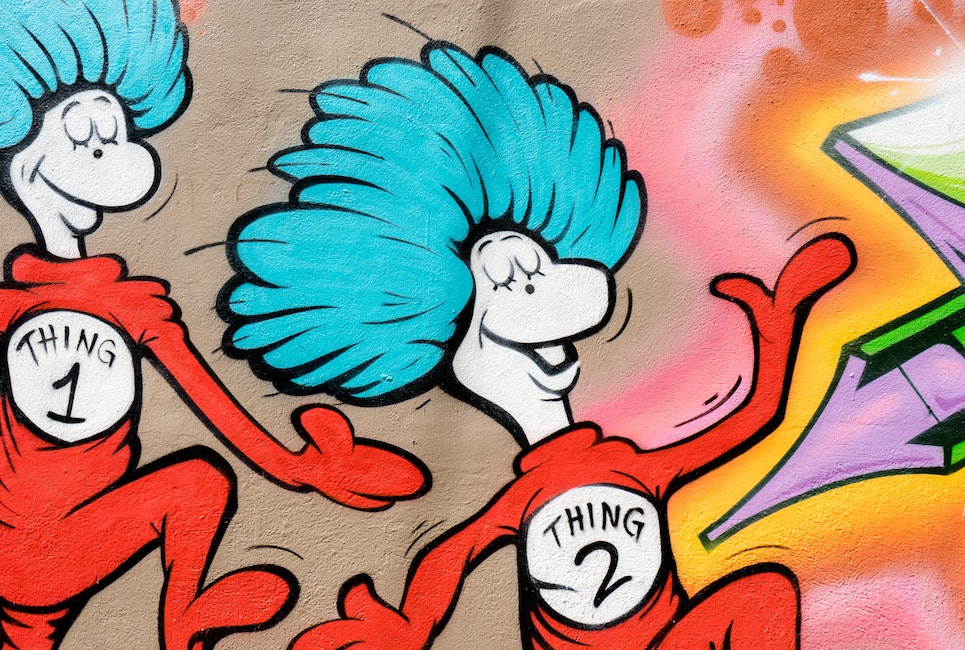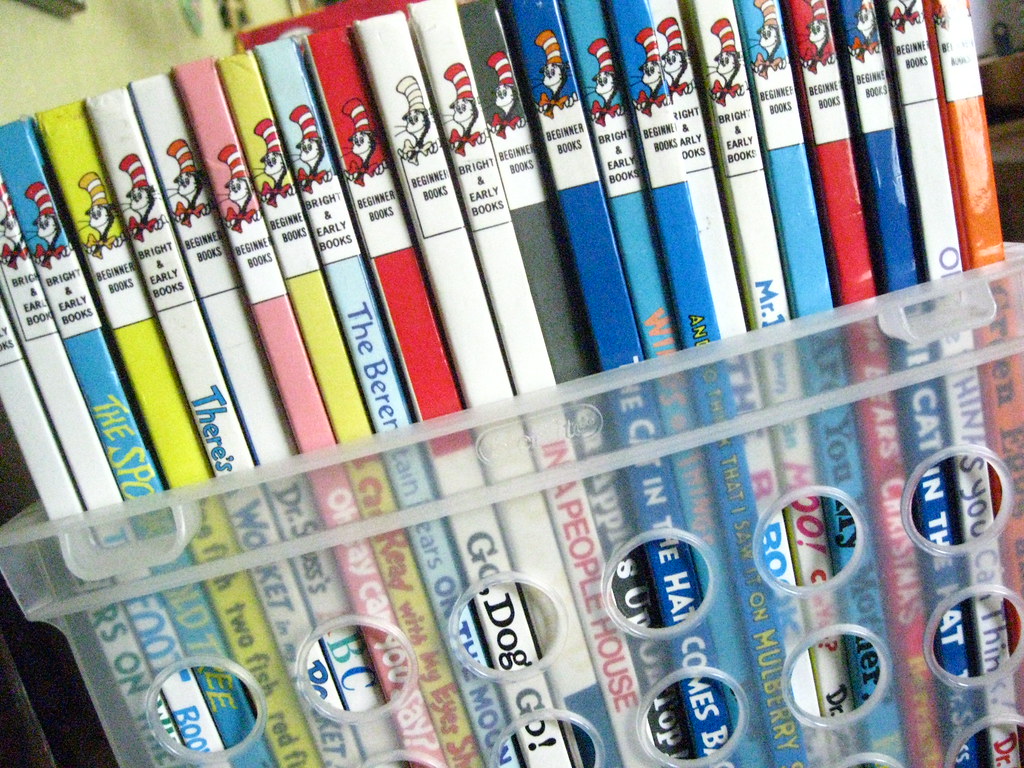
There’s a passage from the childhood classic One Fish Two Fish, Red Fish Blue Fish that I personally consider to be the best story ever told:
My hat is old, my teeth are gold.
I have a bird I like to hold.
My shoe is off, my foot is cold.
My shoe is off, my foot is cold.
I have a bird I like to hold.
My hat is old, my teeth are gold.
And now my story is all told.
Good storytelling is a powerful thing. People don’t engage with products or data; they engage with stories. In the world of business, one of the best skills you can cultivate is how to tell a story well.

Here are 3 things that made Dr. Seuss such a captivating storyteller that you can add to your toolbox tomorrow:
1. Be brief
“So the writer who breeds more words than he needs, is making a chore for the reader who reads.” – Dr. Seuss
Make your message brief and pointed. You want to give your audience enough, but not too much, to process at one time. If there are a lot of things you want to say, pick the 5 points that are the most important. Think of them as the pillars that hold up the building, organize your story around them.
There’s a lot you can convey with just 5 points. Think about all we can infer and imagine about the narrator of the passage above by knowing that he’s got an old hat, gold teeth, and a beloved bird, and that one of his shoe’s has come off, leaving his foot cold. The selection of what you consider important is, in many ways, the real story.
Being brief is not easy. As a brand strategist, I am often called upon to create a 10-page deck that captures everything there is to say about a brand. It should be thorough and clear, but easy to digest. It should get everyone excited. This is hard. Most of the time, I start by writing a 50-page deck work backward from there.
Dr. Seuss wrote Green Eggs and Ham on a dare. The challenge was to write an early-reader book that kids would enjoy using a vocabulary of 50 words. When asked if it was easy to do, he replied, “A paragraph in a children’s book is like a chapter in an adult book. [I have] as much responsibility to take as much time and work just as hard as [adult writers] do.”
Being brief is hard, because there are lots of important things to say. Different people have different perspectives that must be captured, and different audiences have different needs that must be addressed. And words are so beautiful and enticing. Early in my career, when I asked a friend to give me feedback on something I’d written, his comment came back, “It must be difficult to write when you love words so much.” Ouch.
But one of the keys to good writing is to keep it lean, and this is especially important in business. Your message must be consistent, so your story must be short enough to be retold the same way every time and tight to be relevant to all the audiences you seek to reach.

2. Be honest.
Another aspect to telling great story is honesty. The whole point of storytelling is to relate to other people, to connect and engage, and you can only do that if you are genuinely being yourself. Seuss’ shabby, shoeless character is being honest about his circumstances. He’s not feeling sorry for himself, but he’s also not sugar-coating things. He’s humble, and he’s relatable.
In the world of branding, we talk a lot about authenticity–for example, when you’re writing your brand’s backstory. It’s the sense that something is real or genuine that draws people to a brand. They can feel it, smell it.
Mud Coffee, the NYC-based coffee company that originated by selling its own blend out of a van, does it well. They tell the story of how the opening of side by side outlets of the ‘generic coffee monster’ inspired Mud’s founders to double park their truck out front and serve their own coffee out of it.
Then came the orange truck, and it parked directly in the middle shining like the sun. It served everybody with a smile, and it had fair prices. It made the best cup of coffee in New York City, and it didn’t discriminate. The smokers smoked, the dogs had bones, and it played sweet soul music. And the chain was broken.
It rings true because it is true.
In a world where consumers are increasingly demanding honesty, transparency and authenticity, large corporate brands sometimes struggle to find their voice. When McDonald’sdeveloped a regional ad campaign called “From Here” intended to highlight the company’s local sourcing practices, they drew a firestorm of criticism. While the ingredients were indeed local, they hailed from large, industrialized environments, where standard chemical-heavy, hard-on-the-earth practices were likely in use – betraying the spirit of the story.
You can’t be something you’re not.
Fundamentally, being honest is an opportunity for you to connect more intimately with your customers. Transparency and integrity establish the credibility that creates brand loyalty. Your messaging should be sincere and straightforward, conveying candidly and directly how your offering will enhance the customer’s life. Anything that smacks of contrived marketer-speak will immediately be rejected and hyperanalyzed. Brand stories that try to write a new mythology will always feel wrong to customers, because authenticity is so effortlessly truthful.
If you’ve got a unique and amazing story, tell it. For everyone else, good storytelling advice is the same as good relationship advice. Listen. Respond. Show you care. Show you understand. Build trust. Be generous. These are the ways to inspire love. And with love comes loyalty, perhaps for a lifetime.

3. Be memorable
With so many messages trying to cut through the clutter, yours needs to be memorable. Brevity and authenticity help. Another thing to consider is repetition. I had a high school English teacher who advised that our essays should always have 3 parts: tell them what you’re going to say, say it, and tell them what you’ve just said. I’ve used his advice throughout my career. Dr. Seuss’s take? Tell them once, then tell them again — but backwards, to make it interesting.
Being quirky helps too – it was certainly part of Seuss’s magic. Telling your story in an unexpected way gets people’s attention. When mathematician Benoit Mandelbrot discovered a new class of mathematical shapes, he gave them a quirky name–fractals–and used their geometry to tell stories. He explained how galaxies cluster, how wheat prices change over time and how mammalian brains fold as they grow. These stories captured the popular imagination and fundamentally changed how people viewed the world.
Be brief. Be honest. Be memorable. These guidelines are as relevant for marketers as they are for children’s book authors. The presentations we make at meetings could benefit from reading a bit more like Dr. Seuss. Keep it short. Speak from the heart. Give them something to remember.
I just finished reading The Overstory, an extraordinary tale of trees and the humans that love them. Following the journeys of their lives, through the epic and the mundane, I was riveted. Author Richard Powers makes 500 pages feel brief. (That’s how you win the Pulitzer Prize.) His characters speak truth. “The best arguments in the world won’t change a person’s mind,” says one, prophetically. “The only thing that can do that is a good story.”
And that’s the power of storytelling: the power to shift minds and change worlds. Because stories lift us up and transport us, open our eyes and reveal new truths, and in the very best cases, encourage us to evolve for the better. A story may be your greatest strategic tool. Learn how to write a good one.






